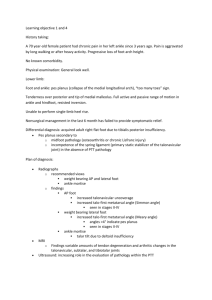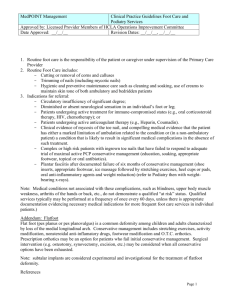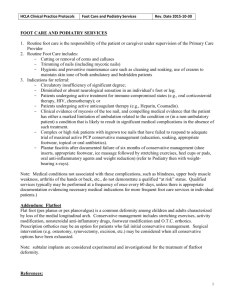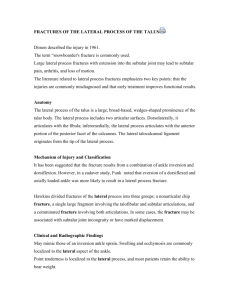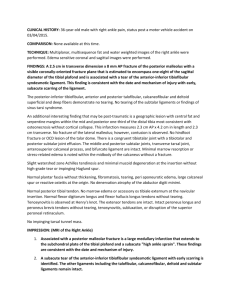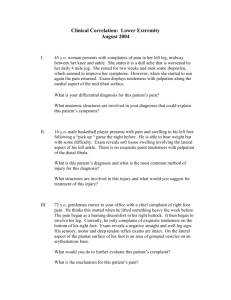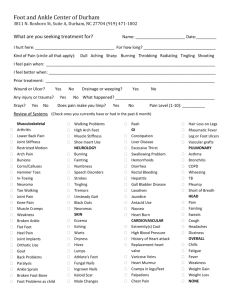56 Subtalar arthritis - American Orthopaedic Foot and Ankle Society
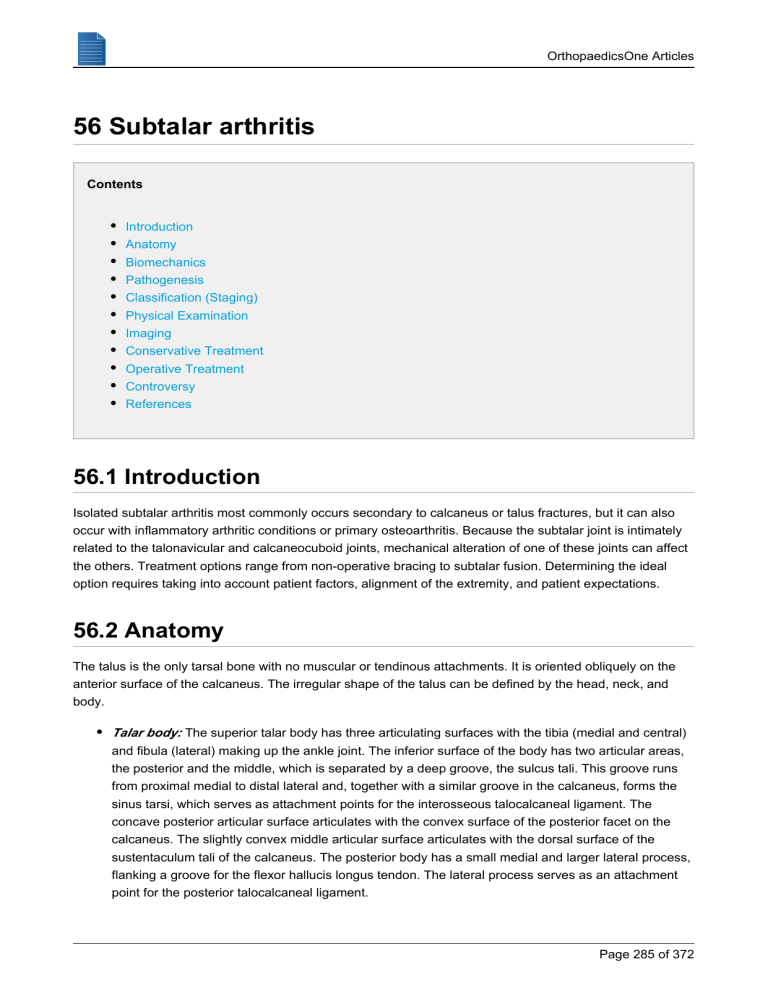
OrthopaedicsOne Articles
56 Subtalar arthritis
Contents
56.1 Introduction
Isolated subtalar arthritis most commonly occurs secondary to calcaneus or talus fractures, but it can also occur with inflammatory arthritic conditions or primary osteoarthritis. Because the subtalar joint is intimately related to the talonavicular and calcaneocuboid joints, mechanical alteration of one of these joints can affect the others. Treatment options range from non-operative bracing to subtalar fusion. Determining the ideal option requires taking into account patient factors, alignment of the extremity, and patient expectations.
56.2 Anatomy
The talus is the only tarsal bone with no muscular or tendinous attachments. It is oriented obliquely on the anterior surface of the calcaneus. The irregular shape of the talus can be defined by the head, neck, and body.
Talar body: The superior talar body has three articulating surfaces with the tibia (medial and central) and fibula (lateral) making up the ankle joint. The inferior surface of the body has two articular areas, the posterior and the middle, which is separated by a deep groove, the sulcus tali. This groove runs from proximal medial to distal lateral and, together with a similar groove in the calcaneus, forms the sinus tarsi, which serves as attachment points for the interosseous talocalcaneal ligament. The concave posterior articular surface articulates with the convex surface of the posterior facet on the calcaneus. The slightly convex middle articular surface articulates with the dorsal surface of the sustentaculum tali of the calcaneus. The posterior body has a small medial and larger lateral process, flanking a groove for the flexor hallucis longus tendon. The lateral process serves as an attachment point for the posterior talocalcaneal ligament.
Page 285 of 372
OrthopaedicsOne Articles
Talar neck: The talar neck consists of the constricted portion of the talus between the body and the head. It has roughened upper and medial surfaces for ligamentous attachements. Its lateral concave surface is continuous with the sinus tarsi.
Talar head: Distally, there is a large, oval, convex articular surface that is congruent with the concave navicular surface. The inferior surface has two facets: The medial facet rests on the plantar calcaneonavicular ligament adjacent to the middle calcaneal facet, and the lateral facet (or anterior calcaneal articular surface) is a flattened surface that articulates with the facet on the upper surface of the anterior part of the calcaneus.
Ligaments: Ligaments that contribute to subtalar stability can be divided into three layers. The superficial layer consists of the calcaneofibular, lateral talocalcaneal, medial talocalcaneal, and posterior talocalcaneal ligaments and the lateral root of the inferior extensor retinaculum. The intermediate layer consists of the cervical (or anterior talocalcaneal) ligament and the intermediate root of the inferior extensor retinaculum. The deep layer includes the strong interosseous talocalcaneal ligament and the medial root of the inferior extensor retinaculum. A capsule encompasses a synovial membrane that runs continuous with the talocalcaneonavicular and calcaneocuboid joints.
56.3 Biomechanics
The subtalar, or talocalcaneal, articulation is a uniaxial joint that functions like that of a mitered hinge, translating motion from the transverse tarsal joint distally to the tibiotalar joint proximally. Although there is variability, the subtalar axis deviates approximately 23 degrees medial to the long axis of the foot in the for 30 degrees of inversion and 15 degrees of eversion.
During initial heel strike, the slightly inverted subtalar joint rapidly everts, resulting in parallelism of the talonavicular and calcaneocuboid joints, allowing the transverse tarsal joints to become more supple. This is important for energy dissipation at the time of ground impact. Eversion is maximal at foot flat, then progressively inverts until toe-off. Inversion of the subtalar joint causes the talonavicular and calcaneocuboid joint axes to diverge, giving stability to the transverse tarsal joints and medial longitudinal arch, stiffening the foot for a rigid lever during toe-off. Isolated fusions of the subtalar joint reduce talonavicular joint motion by
74% and calcaneocuboid joint motion by 44%.
2
56.4 Pathogenesis
Isolated subtalar arthritis can result from:
Trauma (calcaneal/talus fractures)
Primary talocalcaneal arthritis (instability/deformity)
Symptomatic residual congenital deformity (talocalcaneal coalition)
Posterior tibial tendon dysfunction
Inflammatory arthritis isolated to the subtalar joint
3
Page 286 of 372
OrthopaedicsOne Articles
In a review of subtalar arthrodesis, Davies et al reported on 92 patients with 95 feet requiring fusion, with
67% for post-traumatic arthritis, 23% for primary osteoarthrosis, 5.3% for tarsal coalition, and 4.2% for inflammatory joint disease.
4
Post-traumatic arthritis often require subtalar arthrodesis:
Of the calcaneal fractures treated operatively, 3.3% require subtalar fusion.
Of the calcaneal fractures treated non-operatively, 16.9% require subtalar fusion.
Non-operatively treated calcaneal fractures are 5.5 times more likely than operatively treated calcaneal fractures to require a subtalar arthrodesis.
5
Talar neck fractures have an incidence of arthrosis of 30% to 90%, mostly subtalar.
The rate of arthrodesis following fixation of a talus fracture ranges from 10% to 15%.
6
Anatomic variations of the sustentaculum tali may predispose patients to instability and formation of talocalcaneal arthritis. An anatomic cadaver study examining sustentaculum tali morphology and associated arthritis found significantly higher rates of arthritis in specimens with long continuous facets (65%) and medial only facets (50%) when compared to separate anterior and medial facets (35%). It was hypothesized that these morphological variations of the sustentaculum tali may predispose people to joint instability, ligamentous laxity, and the development of arthritic changes in the subtalar joint.
7
56.5 Classification (Staging)
Stage 0 - Normal joint or subchondral sclerosis
Stage 1 - Presence of osteophytes without joint-space narrowing
Stage 2 - Joint-space narrowing with or without osteophytes
Stage 3 - Subtotal or total disappearance or deformation of joint space
56.6 Physical Examination
The patient history should include the exact nature, location, duration, and progression of symptoms, as well as aggravating and alleviating factors and prior therapeutic interventions. Equally important is to identify the extent of disability and the goals/expectations that the patient has for any treatment.
Patients with symptomatic hindfoot arthritis often report pain, swelling and stiffness of the foot that is aggravated by ambulating on uneven ground. Subtalar joint pain is often felt in the lateral hindfoot and may be accompanied by feelings of instability, catching, or locking. Pain often gets better with rest or by wearing high-top shoes.
Physical examination begins with observation of barefoot alignment during standing and walking. Gait disturbances, position of the foot, and overall alignment should be assessed. Excessive hindfoot varus or valgus and areas of swelling and tenderness should be noted. The joints of the hindfoot and midfoot should be assessed for motion and generation of any pain. Specific findings to the subtalar joint include hindfoot swelling, tenderness within the sinus tarsi, pain with inversion/eversion of the hindfoot, limited range of motion of the subtalar joint, and an antalgic gait. The heel cord and gastrocnemius should be evaluated for tightness. As always, a detailed neurovascular examination should be performed to determine weakness, loss of sensation and the presence of pulses.
8
Page 287 of 372
OrthopaedicsOne Articles
56.7 Imaging
Weight-bearing radiographs are essential to accurately assess alignment and the degree of degenerative changes in the joints. Typical views to evaluate the subtalar joint include AP, oblique, and lateral radiographs of the foot. AP, lateral, and mortise views of the ankle are necessary to evaluate any tibiotalar joint asymmetry or pathology.
Additonal radiographs may include:
Broden’s view (LE internally rotated 45 degrees; X-ray angled 10-40 degrees cephalad) to evaluate the posterior subtalar facet
Canale view (AP view of foot in 15 degrees of pronation with X-ray aimed 75 degrees from horizontal) to evaluate the sinus tarsi
CT or MRI may be necessary advanced studies to evaluate for avascular necrosis or subtle arthritic changes, but are not routinely ordered.
8
Diagnostic injection of local anesthetic into the subtalar joint may help confirm the diagnosis and can be combined with corticosteroid to provide therapeutic relief.
56.8 Conservative Treatment
Non-steroidal anti-inflammatory drugs and/or analgesics
Physical therapy for range of motion, strengthening, and proprioception
Activity modification to help avoid painful activities
Braces, shoe modifications, orthotics, or patellar tendon bearing brace with the following goals:
Limit painful joint motion
Accommodate rigid deformity
Correct flexible deformity
Relieve pressure points
Subtalar joint injections
Injections can be a valuable diagnostic tool, but there is little literature to support therapeutic treatment with improvement in pain and motion for up to 6 months following a corticosteroid injection.
10
Another study investigating the efficacy of viscosupplementation with 5 weekly injections found that 86.7% of patients were satisfied at a 6-month follow-up visit.
11
56.9 Operative Treatment
Subtalar arthrodesis is indicated for arthritis, pain, instability, residual coalition, or deformity of the talocalcaneal joint that has failed conservative treatment. It is superior to double or triple arthrodesis with regard to preservation of motion at the talonavicular and calcaneal-cuboid joints. The primary goals are to achieve pain relief and restore hindfoot alignment.
Page 288 of 372
OrthopaedicsOne Articles
While many techniques exist, the procedure essentially consists of removing the cartilage and subchondral bone from the joint and fixating the joint in an aligned position.
12,13
56.9.1 Patient Positioning
Techniques have been described with patients in the lateral decubitus, prone, and supine positions. While the lateral decubitus position makes a lateral approach more accessible, it may be difficult to maintain a proper reference during hindfoot alignment. The supine position with an ipsilateral hip bump allows for proper exposure as well as for maintaining a reference for alignment. The prone position has been described for arthroscopic and open techniques.
12
56.9.2 Approach
The most common approach involves a lateral incision approximately 1 cm below the lateral malleolus towards the base of the fourth metatarsal. Other techniques used include an oblique incision over the sinus tarsi and a posterolateral approach. Arthroscopic subtalar arthrodesis is indicated for in situ fusion where deformity correction is not needed. This has been shown to have equivalent union rates and clinical outcomes to open arthrodesis without any major neurovascular complications.
8
56.9.3 Cartilage Removal
Creating bleeding surfaces of the subtalar joint is an important step in obtaining a solid fusion. Due to the complex shape of the joint, this can be difficult. The use of lamina spreaders, distraction devices (such as
Crego elevators), or non-invasive distractors (Hintermann Distractor) can help with exposure. Once the subtalar joint is visualized, articular cartilage can be removed utilizing a chisel and curette. Drill or K-wire holes are then created in the denuded articular surfaces and can be augmented with larger holes, burr, or feathering of the subchondral bone.
56.9.4 Bone Graft
Bone graft is used to supplement bone healing, fill bone defects, or help with alignment correction if needed.
Options include autograft; allograft; and cancellous, cortical, or corticocancellous bone graft.
Autografts are harvested from the iliac crest, tibia, fibula or calcaneus. Additional surgery and donor site morbidity exists when grafts are harvested from other than local sites.
Structural allografts have been shown to have comparable results to structural autograft for restoration of hindfoot function and alignment during subtalar distraction arthrodesis.
14
Cancellous grafts are used to fill wedges and increase the surface area for bone healing.
Cortical grafts provide a strong strut, suitable for deformity correction, but carry a higher risk of non-union or prolonged time to union when compared to cancellous grafts.
Corticocancellous grafts are a good alternative to provide structural support without the disadvantages that cortical grafts have.
12
Page 289 of 372
OrthopaedicsOne Articles
Bioadjuvants, such as bone stimulators, platelet rich plasma, and demineralized bone matrix, are promising for increasing rates of union, especially in challenging cases, but more studies are needed to elucidate their role in hindfoot surgery.
8
56.9.5 Fixation
Compression of the bony surfaces is important to achieve fusion across the subtalar joint. The joint should be fixed in 5 degrees of valgus alignment. Fusing the foot in varus will lock the transverse tarsal joint, leading to increased lateral forefoot pressures with weight-bearing. Fusing the subtalar joint in excessive valgus can
Controversy section below).
56.9.6 Post-Operative Care
It is standard to limit weight-bearing until evidence of union following subtalar arthrodesis. Usually 6 weeks of limited weight-bearing followed by 6 weeks of protected weight-bearing in a cast or walking boot is prescribed. If radiographic union is appreciated at the 12-week point, the patient is weaned out of the walking boot and begins gentle range-of-motion exercises. However, some authors will allow full weight-bearing as tolerated at any time following surgery with only minor complications and high rates of union.
12
56.9.7 Patient Factors
Patients with obesity, diabetes, rheumatoid arthritis, or severe neuromuscular problems tend to have a poorer prognosis. More severe deformity and the need to perform tendon transfers also portends a poorer outcome. Smoking has a significant influence on achieving bony union, with a 73% union rate in smokers fixation, and post-operative care should be tailored to each patient.
56.10 Controversy
Implant choice and technique can vary from surgeon to surgeon. Implants that have been used include no screws, one screw, Kirschner wires, two screws, or staples. Placement of the screws has been done from anterior, posterior, or plantar approaches. The use of press-fit bone grafts or Kirschner-wire fixation has significant rates of non-union and malalignment; therefore, use of an implant that provides compression is advocated.
The most common implant used is the screw. Some authors prefer the single screw technique, but this configuration may not be adequate in all situations as rotation cannot be controlled with one point of fixation.
3
56.10.1 Single-Screw Technique
Page 290 of 372
OrthopaedicsOne Articles
Single lag screw placement from posteroinferior calcaneus to anterior talar neck is effective for subtalar fusion.
12
No significant differences were observed in nonunion rate, postoperative complication incidence, or subsequent surgeries when comparing single-screw to two-screw fixation of isolated subtalar fusions.
16
56.10.2 Two-Screw Technique
Biomechanically, the double diverging two-screw configuration has been shown to achieve the most compression and torsional stiffness and the least joint rotation.
17
A finite element analysis showed that one screw in the talar neck and another in the posteromedial talar dome provided the best two-screw configuration.
18
56.10.3 Plantar Screw
The plantar-to-superior fixation technique allows for slightly more compression across the subtalar joint
(604N vs 581N) and can provide an alternative to the posterior-to-anterior technique in revision situations.
19
56.11 References
1. Coughlin, Mann, Saltzman. Surgery of the Foot and Ankle. 8th ed. Philadelphia, PA, Mosby Inc. 2007.
2. Astion DJ, Deland JT, Otis JC, Kenneally S. Motion of the hindfoot after simulated arthrodesis. J Bone
Joint Surg Am 1997;79A:241-246.
3. Easley M, Trnka H, Schon L, Myerson M. Isolated Subtalar Arthrodesis. J Bone Joint Surg 2000;
82:613-
4. Davies M, Rosenfeld P, Stavrou P, Saxby T. A Comprehensive Review of Subtalar Arthrodesis. Foot
& Ankle International. 2007 Mar;28(3):295-7.
5. Buckley R, Tough S, McCormack R. Operative compared with nonoperative treatment of displaced intra-articular fractures: a prospective, randomized, controlled multicenter trial. J Bone Joint Surg Am
2002;84:1733-44
6. Vallier H, Nork S, Barei D, Benirshke S, Sangeorzan B. Talar Neck Fractures: Results and Outcomes.
J Bone Joint Surg 2004;86:1616-24.
7. Drayer-Verhagen F. Arthritis of the subtalar joint associated with sustentaculum tali facet configuration. J Anat. 1993;183:631-634.
8. Flemister A. Hindfoot Osteoarthritis and Fusion. Orthopaedic Knowledge Update 4: Foot and Ankle.
American Acadamy of Orthopaedic Surgeons 2008;15:195-200
9. Peterson C, Hodler J. Evidence-based radiology (part 2): Is there sufficient research to support the use of therapeutic injections into the peripheral joints? Skeletal Radiol 2010; 39:11-18
10. Ward ST, Williams PL, Purkayastha S. Intra-articular corticosteroid injections in the foot and ankle: a prospective 1-year follow-up investigation. J Foot Ankle Surg. 2008;47:138--44.
11. Sun SF, Chou YJ, Hsu CW, Hwang CW, Hsu PR, Wang JL, et al. Efficacy of intra-articular hyaluronic acid in patients with osteoarthritis of the ankle: a prospective study. Osteoarthritis Cartilage.
2006;14:867--74.
Page 291 of 372
OrthopaedicsOne Articles
12. Tuijthof G, Beimers L, Kerkhoffs G, Dankelman J, van Dijk C. Overview of subtalar arthrodeisis techniques: Options, pitfalls and solutions. Foot and Ankle Surgery. 2010;16:107-116.
13. Operative Techniques in Orthopaedic Surgery, Volume Four. Philadelphia, PA. Lippincott Williams &
Wilkins, 2011.
14. Garras D, Santangelo J, Wang D, Ea M. Subtalar Distraction Arthrodesis Using Interpositional Frozen
Structural Allograft. Foot & Ankle Int 2008;29:561-7.
15. Haskell A, Pfeiff C, Mann R. Subtalar joint arthrodesis using a single lag screw. Foot Ankle Int
2004:25:774-7
16. DeCarbo WT, Berlet GC, Hyer CF, Smith WB. Single-screw fixation for subtalar joint fusion does not increase nonunion rate. Foot Ankle Spec 2010;3(4):164-6.
17. Chuckpaiwong B, Easley M, Glisson R. Screw Placement in Subtalar Arthrodesis: A Biomechanical
Study. Foot Ankle Int 2009;30:133-41.
18. Lee J, Lee Y. Optimal double screw configuration for subtalar arthrodesis: a finite element analysis.
Knee Surg Sports Traumatol Arthrosc 2011;19:842-9.
19. Gasch C, Verrette R, Lindsey D, Beaupre G, Lehner B. Comparison of initial compression force across the subtalar joint by two different screw fixation techniques. J Foot Ankle Surg.
2006;45(3):168-73.
Page 292 of 372
